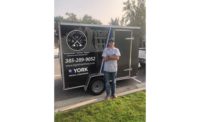NAVAC prides itself on developing new, innovative vacuum solutions and tools for the HVAC industry through intensive research and development. At this year’s AHR Expo, the manufacturer showcased its newest advancements.
The first, the NRDC4M, is a brushless DC recovery unit. The product features inverter technology and a four-cylinder structure, along with dual oil-free compressors, a purge function, and high-speed cooling fans.
“In size and capabilities, it’s for heavy commercial and industrial applications,” said Andrew Greaves, northern U.S. regional manager for NAVAC. “So it’s a two-compressor, three-fan, four-cylinder recovery machine.”
The product features a backlit display that gives the technician more precise knowledge about what is happening in the system. With a backlit display, Greaves explained, the technician also has the ability to toggle between running the compressors in parallel or in series.
“It gives them a lot more control towards the end of the recovery, when we have very low pressure vapor remaining in the system,” Greaves said. “It’s time consuming, and changing this machine to run in series drive helps drive that pressure off and finish strong. So this is going to be an extremely light, fast, and quiet machine for commercial technicians that do chiller work and large tonnage package.”
Greaves said that the size of the product is a strong benefit, since contractors will not need to move vacuum pumps that are significantly larger. The product is 40 pounds, transportable with a single-hand shoulder strap.
HAVAC also featured the NP4DLM, a cordless, battery-operated vacuum pump. According to Greaves, the product is next in line from NAVAC’s NP2DLM, a product that won the gold award in The ACHR NEWS’ 2019 Dealer Design Awards in the Electronic & Hand Tools category. The NP2DLM had such good reception that NAVAC continued to improve upon the technology.
“So we doubled in size, from two to four cfm, the battery changed from five amp hour to nine amp hour, and it still has up to an hour runtime,” he said. The NP4DLM is designed for residential and light commercial applications and weighs only 15.4 pounds. Along with the size and capacity potential, the vacuum tree has improved, Greaves explained. There are ¼-inch, 3/8-inch, and ½-inch ports, and large diameter hoses that can be taken off the pump directly to the equipment. Since the pumps are lower on the cfm scale, Greaves explained that having large diameter hoses is critical, removing restrictions, removing the Schrader cores with a proper core removal tool, and using a quality micron gauge.
The product also features an isolation ball valve, as well as a backflow prevention check valve, and brushless DC technology. A gas ballast aids on moisture management, and a built-in lifting hook allows for users to move the vacuum pump up to roofs safely.
Greaves explained that NAVAC is working hard to improve upon its battery technology. Battery technology becomes more expensive the larger and more powerful the products get, and it needs to stay accessible to the contractor. However, a battery also needs to be small enough to use conveniently, and NAVAC is working hard, Greaves said, to continue making battery technologies that are small, convenient, efficient, and cost-effective.
NAVAC designed the battery-operated NEF6Li flaring tool, which Greaves said creates a consistent flare time and time again. The product comes with four tube holders, six flare dies, two batteries, a charger, and a tubing cutter and a deburring tool. The flare tool can help create a quality installation, especially during installations of ductless equipment, which Greaves said is a trend NAVAC is seeing.
“When you have these startup issues, and the callbacks and the warranty issues, a lot of times it comes right back to installation,” he said. “And a big percentage of that ends up being with the flaring.”
Automating the process with a tool like the NEF6Li, offering a consistently flare each time, can give contractors confident that their technicians are flaring properly.
See more articles from this issue here!








